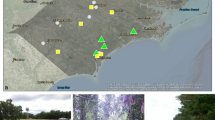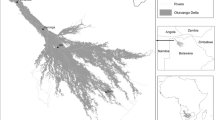Abstract
Interest in the restoration of riparian habitat is increasing. However, little is known about factors responsible for riparian communities, especially grasslands. In order to construct plant communities for a restoration project in the floodplain of a large river in the Midwestern United States, we sampled four floodplains with various disturbance regimes located in Illinois and Missouri. They were chosen to be representative of different plant communities of floodplains, with a focus on herbaceous communities. The areas included backwater lakes, alluvial fans, groundwater seep marshes, oxbow marshes, seasonally inundated grassland, and non-inundated grassland. Vegetation, soils and groundwater or standing water depth were measured at various intervals along transects. Communities were produced using TWINSPAN and tested for differences in environmental factors. The soil morphology, taxonomic classification, and fertility parameters were similar among sites. Environmental factors influencing community composition were the presence of permanent water and silt deposition. We conclude that water depth determines species composition in permanently wet areas. Silt deposition determines composition in seasonally inundated grassland. Where silt deposition is high enough to inhibit seedling emergence, dominance is attained by plants able to reproduce vegetatively by rhizomes. Such a reproductive process leads to nearly monotypic stands produced by large clones. Results are discussed in relation to models of riparian processes and succession.
Similar content being viewed by others
References
Barrows H.H. 1910. Geography of the Middle Illinois Valley. Bulletin No. 15 ed. University of Illinois, Urbana, Illinois: Illinois State Geological Survey.
Betz R. 1986. Ten years of prairie restoration at Fermilab. Proceedings of the twelfth North American Prairie Conference. Cedar Falls, Iowa. University of Northern Iowa Press.
Connell J.H. 1978. Diversity in tropical rainforest and coral reefs. Science 199: 1302–1310.
Dahnke W.C. (Ed.), 1988. Recommended chemical soil test procedures for the North Central Region. No. Dak. Agri. Exp. Sta. Bull. 499 (rev.). Fargo, North Dakota.
Day R.A., Keddy P.A., McNeill J. and Carleton T. 1988. Fertility and disturbance gradients: a model for riverine marsh vegetation. Ecology 69: 1044–1054.
Evans D.K. 1978. Floristics of the middle Mississippi River sand and mud flats. Castanea 43: 8–24
Hey D.L. and Phillipi N.S. 1999. A case for wetland restoration. New York: John Wiley and Sons, inc.
Junk W.J., Bayley P.B. and Sparks R.E. 1989. The flood pulse concept in river-floodplain systems. pp. 110–127. In: Dodge D.P. (Ed.), Proceedings of the International Large River Symposium (LARS); Honey Harbor, Ontario, Canada. Ottawa, Canada: Department of Fisheries and Oceans.
Kofoid C.A. 1903. Plankton Studies. Bulletin of the Illinois State Laboratory of Natural History 6: 95–574.
McCune B. and Mefford M.J. 1997. Multivariate analysis of ecological data, version 3.0. MJM Software, Gleneden Beach, Oregon.
Middleton B. 1999. Wetland Restoration, Flood Pulsing and Disturbance Dynamics. New York: John Wiley and Sons, inc.
Missouri Department of Conservation. 1995. Minutes, Missouri Natural Areas Committee.
Mohlenbrock R.H. 1986. Guide to the vascular flora of Illinois. Southern Illinois University Press, Carbondale, Illinois.
Morrison D.A., Le Brocque A.F. and Clarke P.J. 1995. An assessment of some improved techniques for estimating the abundance (frequency) of sedentary organisms. Vegetatio 120: 131–145.
Naiman R.J. and Melillo J.M. 1984. Nitrogen budget of a subarctic stream altered by beaver (Castor canadensis ). Oecologia 62: 150–155.
Nelson J.C. 1999. The presettlement Mississippi and Illinois river valleys: a look at the past to identify and restore endangered natural communities. p. 7. In: Vegetation of the upper Mississippi and Illinois River systems: status, management and ecological linkages, A symposium of the Upper Mississippi River Conservation Committee. September, 1999, La Crosse. Wis.
Nelson P.W. 1987. The Terrestrial Natural Communities of Missouri. Missouri Natural Areas Committee.
Pickett S.T.A., Collins S.L. and Armesto J.J. 1978. Models, Mechanisms and Pathways of Succession. The Botanical Review 53: 335–372.
Poff N.L., Allan J.D., Bain M.B., Karr J.R., Prestegaard K.L. Richter B.D., Sparks R.E. and Stromberg J.C. 1997. The Natural Flow Regime, A paradigm for river conservation and restoration. Bioscience 47: 769–784.
Ridgeway R. 1872. Notes on the Vegetation of the Lower Wabash Valley; I. The Forests of the Bottomlands. American Naturalist 6: 658–665.
Schramm P. 1992. Prairie restoration: A twenty-five year perspective on establishment and management. Proceedings of the twelfth North American Prairie Conference. Cedar Falls, Iowa. University of Northern Iowa Press.
Soil Survey Staff. 1999. Soil Taxonomy. 2nd ed. Agricultural Handbook 436. Washington, D.C., USDA, Natural Resources Conservation Service.
Sparks R. E., Bayley P.B., Kohler S.L. and Osborne L.L. 1990. Disturbance and recovery of large floodplain rivers. Environmental Management 14: 699–709.
SPSS inc. 1996. SYSTAT ver. 6.0. Chicago, Illinois, USA.
Toner M. and Keddy P. 1997. River hydrology and riparian wetlands: a predictive model for ecological assembly. Ecological Applications 7: 236–246.
Turner L.M. 1932. Grassland in the Floodplain of Illinois Rivers. Transactions of the Illinois State Academy of Sciences 71–72.
Turner L.M. 1934. Grassland in the Floodplain of Illinois Rivers. American Midland Naturalist 15: 770–780.
Turner L.M. 1936. Ecological Studies in the Lower Illinois River Valley. The Botanical Gazette 97: 698–727.
Van Andel J., Bakker I.P. and Grootjans A.P. 1993. Mechanisms of vegetation succession: a review of concepts and perspectives. Acta Botanica Neerlandica 42: 413–433.
Vannote R.L., Minshall G.W., Cummins K.W., Sedell J.R. and Cushing C.E. 1980. The river continuum concept. Canadian Journal of Fisheries and Aquatic Sciences 37: 130–137.
Walters C. 1997. Challenges in adaptive management of riparian and coastal ecosystems. Conservation Ecology [online]1:1. Available from the Internet. URL: http://www.consecol.org/vol1/ iss2/art1
Author information
Authors and Affiliations
Corresponding author
Rights and permissions
About this article
Cite this article
Sluis, W., Tandarich, J. Siltation and hydrologic regime determine species composition in herbaceous floodplain communities. Plant Ecology 173, 115–124 (2004). https://doi.org/10.1023/B:VEGE.0000026335.44232.1c
Issue Date:
DOI: https://doi.org/10.1023/B:VEGE.0000026335.44232.1c




